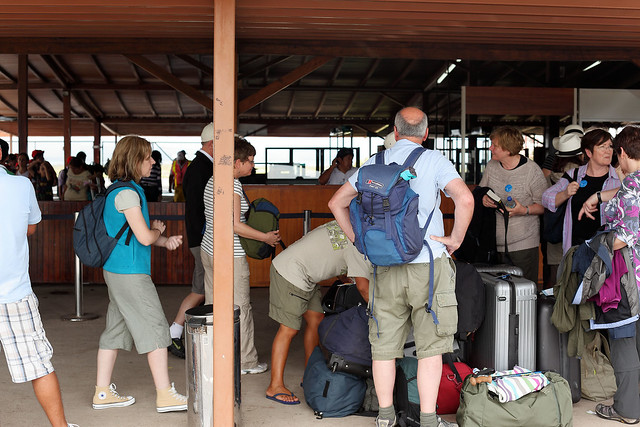
Meeting our tour group at Baltra Airport
[ < < previous | index | next >> ]
We rose, got into fresh clothes, and packed the clothes we'd been wearing on the flights into our luggage. We grabbed breakfast in the hotel restaurant, which had a buffet including cereals, fruits, and breads, plus a guy cooking eggs to order. It was pretty good. Then we checked out and met our first Intrepid representative of the trip, a guy named William, who would be helping us check in to our flight to the Galápagos Islands at Guayaquil airport.
He took us to a car outside which had a driver in it, and as we drove back to the airport William gave us a briefing in good English of what we needed to do. Ecuador tightly controls entry into the Galápagos Islands, and there are a couple of formalities to be go through. Firstly, we needed US$100 each to be paid as an entry fee to the Galápagos National Park on landing. We knew about this already and had the cash on hand. Next, there is a form needed to be filled out with visitor details, which is attached to your passport on entry to the Galápagos and which is removed on departure (even though it's a domestic flight within Ecuador). William said these forms cost US$10 each, and ones had been purchased for us through Intrepid as part of our tour package, but they had been lost in the post to Guayaquil, so he didn't have them for us. He said he would get some new ones for us at the airport when we checked in. At least this is how we figured it out afterwards - it wasn't entirely clear to us at this time.
At Guayaquil airport, William helped us with the check-in procedures, on a flight on the airline TAME. He spoke to a woman at a desk in Spanish for a while, and told us they couldn't give us the forms here, and we'd need to pay US$10 on arrival in the Galápagos for them. It was good having him there to help us through the check-in, because we would have easily spent three times as long without him, and not had the confidence that we'd done everything properly. After completing the procedures for us, William said farewell and we passed through the security check into the departure lounge. We had a bit of time before departure, so used the free wi-fi to connect and send some e-mails to our parents letting them know where we were.
The flight was about 1.5 hours long. Near the end we passed over several islands, before turning and landing on the island of Baltra. At this point I didn't know anything about the geography of the islands, so assumed Baltra was a larger island, with a town on it. As the plane taxied back down the runway, we realised it was pouring rain. Our fears were realised when the plane didn't approach a modern terminal with jetway, but stopped on the tarmac some 200 metres from the small terminal building and a set of mobile steps was pushed up to it. The rain was warm and tropical, but heavy, and not fun to be in when carrying a camera bag. Fortunately, the locals appeared to be well prepared, as they handed out large golf umbrellas from a box full of them to all passengers as they alighted from the steps. Using one of these between us, we managed to reach the terminal without getting too wet, where we left the umbrella in a growing pile under the awning.
The terminal was a relatively primitive affair, being essentially an enormous palm frond roof, supported by posts. There were no walls, only some portable partitions used to corral arrivees into queues for the immigration formalities. We queued, and noticed that everyone else seemed to have some sort of form that they'd filled out, and which the immigration officials were checking and stamping. This was the form which William had told us we'd need to purchase here, but at this point we hadn't figured that out and thought that for some reason the air crew had handed them out to everyone on the plane but us. We didn't have much choice but to blunder on regardless, and when we had our turn with an immigration officer and mimed that we had no form, he asked us for $10 each and gave them to us. It was now that the penny dropped and we realised this was the form William had been talking about earlier. We filled it out quickly at a table then returned to the immigration queue in front of everyone else and had our passports stamped. Then we paid the US$100 park entry fee to another man, and we were through.
The next step was to find our baggage. There was a baggage collection area, but curiously nobody was being allowed into it, but were rather being held back by a low wooden fence and closed gate in it. Making our way over, we saw that airport workers were busy assembling all the bags from the plane into rows on the floor. There were no baggage carousels here. Furthermore, the roof was leaking and rainwater was pooling all over the floor area, so they'd thrown some tarpaulins down to provide some minimal protection against the water for the piles of bags. Finally, after about 15 minutes of waiting, all the bags were assembled and the gate was thrown open for a free-for-all. Hordes of people moved in, searching for and grabbing bags from the rows, then moving to the exit area, where airport staff were very carefully checking baggage claim tickets to make sure people were only taking matching bags. This is the first time I've ever seen anyone check a baggage claim ticket to make sure passengers weren't taking any old bags they wanted.
 Meeting our tour group at Baltra Airport |
While we'd been waiting for this fun to begin, we'd spotted a guy holding a "Galápagos Voyager" card, which was the name of the boat we will be spending the next few days on, as William in Guayaquil had told us. We'd indicated to the guy that we were meeting with him, as soon as we'd picked up our bags. Having done so, we joined a small crowd of people massing around him. He introduced himself as William (yes, another one), and assembled a pile of luggage from everyone, saying that porters would take it for us. He then instructed us to catch one of the public buses waiting outside the terminal in the slackening rain, to some other place where we'd get a private bus for our tour group. It wasn't entirely clear what was going on, but we followed William and the rest of the people with him and climbed on to a large bus where we stood in the aisle.
The bus took us along a winding road across the flat island. We got a look at the low scrubby vegetation, punctuated by tall cactus. After a few minutes of driving, the bus turned down a slope that led to an area next to what looked like a small inlet of water. The water was maybe 100 metres across, but obviously they hadn't bothered building a bridge across the gap, because there were boat terminals on either side and a series of long, covered barges waiting for us. Hundreds of passengers from the plane were milling around, and William told us to get on one of the boats. As we watched, rain started tumbling down again, and porters were throwing everyone's luggage on to the exposed rooves of the barges. An American watching this scene in the bus with us said, "Well, that's comforting."
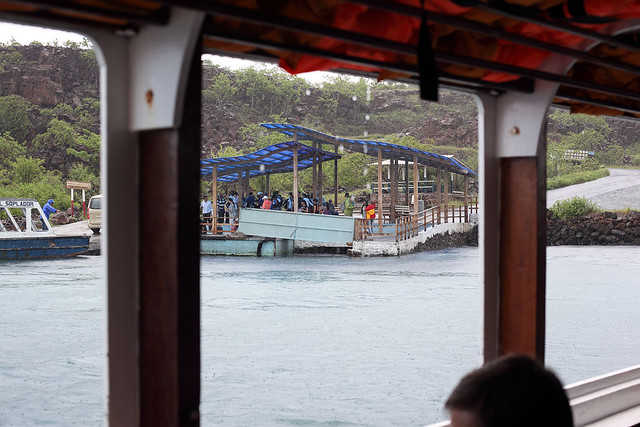 On board the barge crossing from Baltra to Santa Cruz |
We piled aboard a barge with a few dozen other people. We saw the porters were using tarpaulins to cover the bags on the roof, more or less. The rain was fitful now, and hot sun was breaking through the clouds. The barge took us across this small gap of water, and I wondered why the road for the bus didn't simply go around it. Perhaps the terrain was too steep near here, as it was clear that Baltra was mostly a flat plateau, but several metres above the sea level, with cliffs around it.
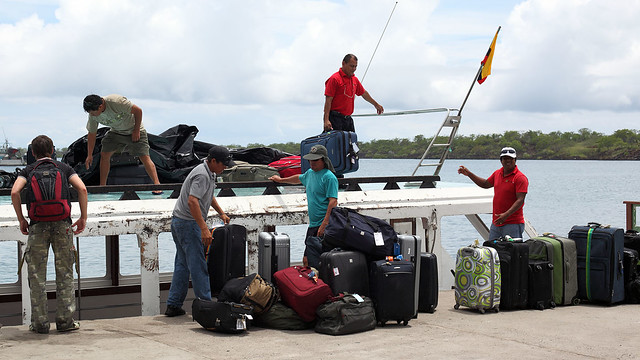 Luggage handlers unloading our bags on the other side |
On the other side of the inlet, we piled out of the barge again, and saw a series of smaller buses and vans and cars lined up waiting to carry people away. Here the passengers from the plane split up into distinct tour groups and some of them started making their way off in the smaller vehicles. Our group was 16 strong, plus William, and it took us a few minutes to get organised and make sure we had everyone's luggage. This was loaded on to the roof of a minibus. While this was happening, I took some photos and noticed a large sign indicating where we were. It turned out that the "inlet" we'd crossed was in fact a piece of sea separating two islands: Baltra to the north, a relatively small island where the airport was, and Santa Cruz, a much larger island to the south. Suddenly it became clear what we were doing - crossing from one island to another. William instructed us to climb in the bus. It lurched into gear and the driver started taking us along another road into the interior of the island of Santa Cruz.
A few minutes into the drive, William had the bus driver pull over and stop the engine. Then for the first time he addressed us properly as a group, introducing himself and explaining what would be happening for the remainder of the day on the tour. The bus hadn't really pulled off the road, and other vehicles beeped us as they roared past. William explained that we'd be stopping at a giant tortoise breeding facility here on Santa Cruz, then heading to the coastal town of Puerto Ayora where our boat awaited in the harbour. We'd transfer to the boat, have lunch on board, then be assigned to our rooms so we could settle in. Then later in the afternoon we'd head back to shore for a visit to the Charles Darwin Research Station, just outside Puerto Ayora, before returning to the boat for dinner.
As promised, the bus drove us several kilometres across the island before turning into a run-down dirt road that led another kilometre or so to the Rancho Primicias tortoise breeding facility. Here we would get our first glimpse of the famous giant Galápagos tortoises. The rain had stopped, but the weather looked changeable and somewhat threatening, with a mixture of blue sky, light cloud, and heavy grey cloud swirling around chaotically above. William led us into a change area where a selection of rubber gumboots were available in different sizes. He instructed us to change into a pair, since the walk around the breeding facility would be muddy. He also advised taking rain jackets or ponchos, in case the rain started again. We had no real choice here, since our ponchos were in our large luggage, strapped to the top of the bus.
 Spotting giant tortoises at Rancho Primicias |
The walk took us around a grassy area between stands of trees. Amongst this, we came across a few of the giant tortoises, grazing peacefully on grass and flowers, or dozing under trees. We also saw several small birds flitting around, though these were hard to get a good look at. There was a weed-covered pond in which were swimming several Galápagos pintail ducks. As we were walking around the tortoise facility, rain started to fall. It was light, so we didn't get too wet, but we were ready to run for shelter if it got heavy. Fortunately it eased off rather than got heavier, and we were okay to continue our walk.
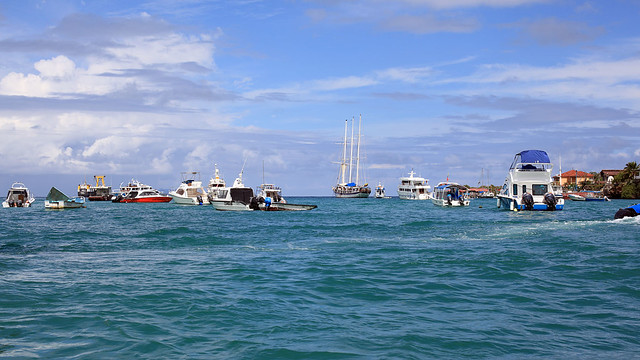 The harbour at Puerto Ayora |
After this, we boarded the bus again and drove to the small town of Puerto Ayora, which had a picturesque harbour full of boats fronting on to a small plaza and colourful whitewashed buildings. We boarded rubber dinghies and were instructed to don life jackets. Eight of us fit into each of two dinghies, plus a motor operator and William. They took us out into the harbour, past most of the boats moored there, to a small cruiser anchored near the outer edge of the bay. This was the Galápagos Voyager, and to be our home for the next three days.
 Common lounge and dining area on board the Galápagos Voyager |
Our first instruction was to take our shoes off and leave them on the aft deck where the dinghies let us off. Walking around the boat a bit to get our bearings, we saw an enormous brown pelican standing on the bow. It seemed unconcerned as we approached and took photos. Then we proceeded inside into the main deck lounge and dining area. Tall glasses of freshly squeezed juice were awaiting us, which were delicious after the active morning. It was already after 13:00, so we were hungry, and lunch was served soon after. This was linguini with a choice of sauces: bolognese or a vegetarian tomato sauce, plus salad platters and a tray of what looked like home made banana chips. These turned out to be lightly salted and not sweet, and I realised they were plantain chips. M. liked these a lot.
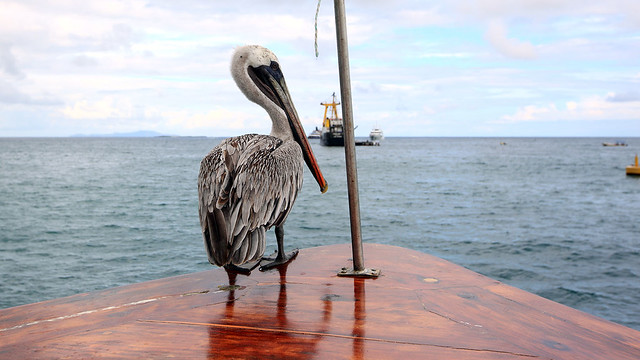 Brown pelican sitting on the bow of the Galápagos Voyager |
After eating, we settled into our cabins. Our luggage had been delivered to cabin 2, on the port side of the main deck, just forward of the dining room. Between us and the dining room were two doors leading down into the lower deck, one into the engine room, from which a whiff of diesel emerged, and the other presumably into the kitchen and storage areas. Our cabin was nice, with twin bunks, a closet with a safe in it, and a private bathroom with toilet and shower. All up, we felt this was pretty good and thought we were going to enjoy this cruise. The only real concern for me was the motion of the boat on the harbour swell, which was considerable. I'd been seasick once before, and was determined not to let it affect me this time. I spent the first day on board staring at the horizon rather than at things on the boat, which seemed to do the trick. Although I felt slightly uncomfortable for a while, I never ended up getting sick, which was good.
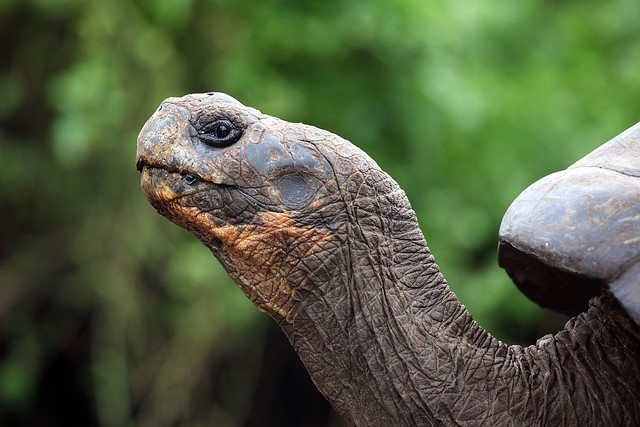 Giant tortoise at the Charles Darwin Research Station |
The group met on the aft deck at about 15:00 for a land excursion back to Puerto Ayora. The rubber dinghies took us back to the town and from there William hailed taxis for us in groups of four to take us to the Charles Darwin Research Station on the eastern side of the town. Once reassembled there, William led us on a walk through the station, along paths that led past breeding cages for giant tortoises. We saw yearling tortoises and ones 2 to 3 years old. They were very small considering the size they can grow to, being easily able to fit into the palm of a hand.
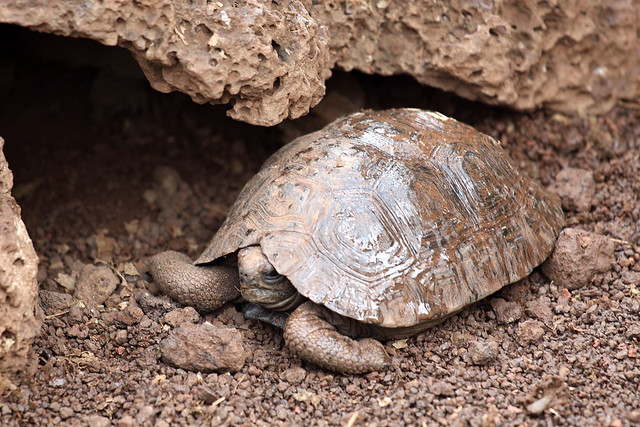 Baby giant tortoise at the Charles Darwin Research Station |
Further on we saw captive specimens of Galápagos land iguanas, then fully grown specimens of giant tortoises. The most poignant was Lonesome George, the only known living specimen of the Pinta Island subspecies Chelonoidis nigra abingdoni. He's been the only known specimen for many years now, and efforts to locate females of his subspecies or to breed him with females of the most closely related subspecies to preserve the genetic identity have so far proved fruitless.
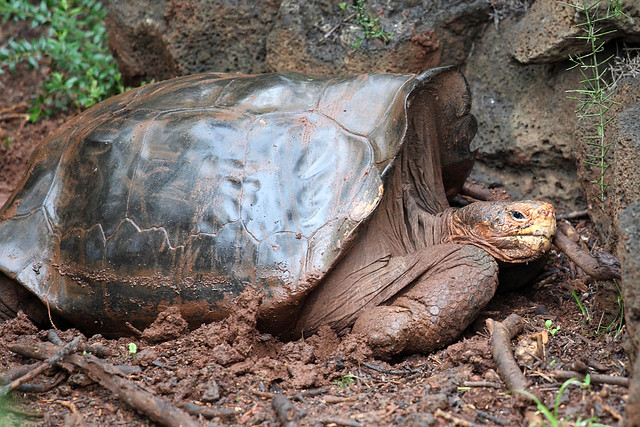 Lonesome George |
The landscape around the station was made of black volcanic rocks, covered with scrubby vegetation, including lots of cactus, particularly prickly pear and a tall fluted species I didn't know the name of. Small birds flitted around, including some of the famous Galápagos finches, though these were too fast and flighty to get decent photos easily. We saw birds that William identified as warbler finches, and yellow warblers. There were also some insects, including some mosquitoes, so we broke out the insect repellent for the first time. A shower gave us our first use of our rain ponchos, but it cleared fairly quickly. The weather remained unsettled looking, but was hot and steamy, so we peeled off the ponchos as soon as we could to avoid overheating.
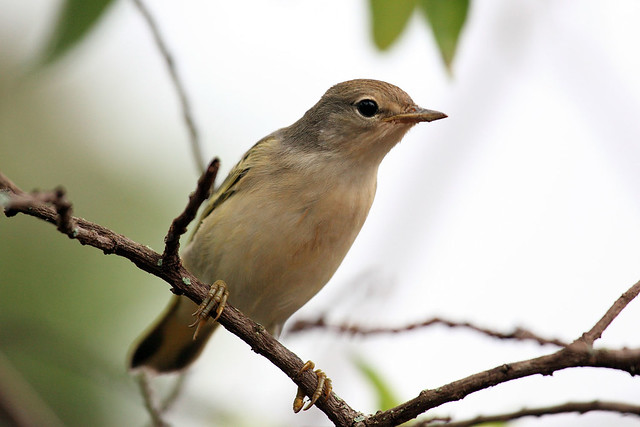 Yellow warbler |
After this brief look at the operation of the Charles Darwin Research Station, William told us to reassemble at the dock at 17:30 for the return trip to the boat. He said we could walk back to Puerto Ayora along the road, keeping to the left with the sea on our left side so we didn't get lost. We had free time until then to explore or shop. Most of the others in our group headed off quickly, but M. and I lagged behind a bit, taking photos and looking around a bit more before leaving the research station. We walked slowly back to town, spotting various birds, a couple of marine iguanas, and even a sea lion along the way. The sea lion was wandering around in a paved area right in the town! Once within the outskirts of Puerto Ayora, we passed several shops in which we stopped to browse. M. bought a bag for her sister in a shop in town.
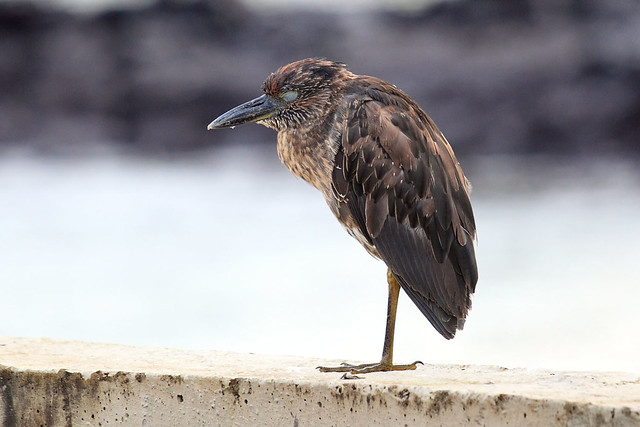 Yellow-crowned night heron, near Puerto Ayora |
We passed a large bronze statue of a giant tortoise which was in the town. Near here, I spotted what I thought was a hummingbird, flitting around a bush sipping nectar from the flowers. I pointed it out to M., then realised it wasn't a bird at all, but an enormous moth, later identified as probably being Eumorpha labruscae, the gaudy sphinx moth, or green hawkmoth. Unfortunately I wasn't quick enough to get a photo. Closer to the dock, we saw a rowdy group of people and animals which turned out to be fishers gutting their catch, surrounded by squawking gulls and, amazingly, a sea lion! It hung around very close to all the people, amazing some of the other tourists watching as well.
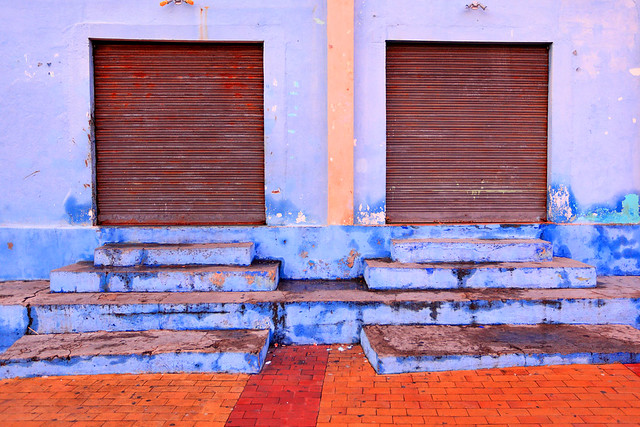 Colourful walls in Puerto Ayora |
Back at the dock we bumped into some of our fellow tour group members and watched a beautiful sunset illuminate the sky. They spotted the rest of our group already climbing into a dinghy nearby, so we rushed over and joined up for the trip back to the Galápagos Voyager. Here we found a light snack of corn chips and nuts plus more fresh juice awaiting us. We assembled in the lounge area for a pre-dinner talk and finally introductions to everyone else in our tour group, this being really the first moment we had to sit down together without doing anything else. Ten of the others in the group of 16 were British, then there was us from Australia, a couple from Austria, and a couple from Spain. There were Jill and David; Lorraine and Suzanne travelling together; Simon and Leonie; Jane and Barry; and Anne and Brian all from England; then Otto and Brigit from Austria; and we never managed to remember the Spanish couple's names - the guy spoke good English, but his partner didn't speak much. William also gave us a description of the next day's activities, then ushered us to begin dinner, introducing our waiter and bartender for the trip, Francesco.
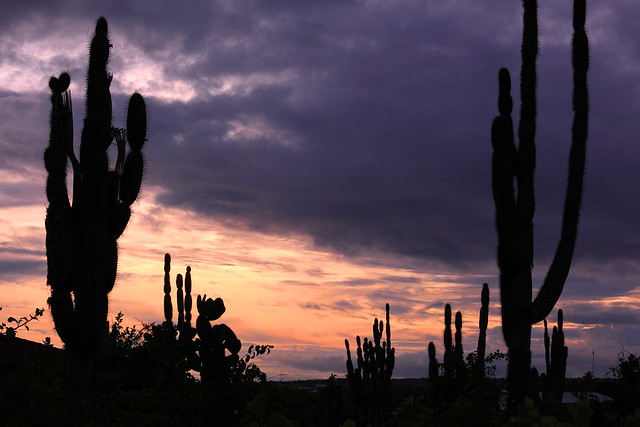 Sunset in Puerto Ayora |
Francesco had laid out a meal of fish pieces, chicken in a sort of sweet and sour sauce, plus vegetables and salads. M. had some of the fish, while I tried a bit of everything. After a busy day, it was good to get a nice hot meal. After this, there was time to relax and socialise, but it seemed everyone was too tired to do so and most of us simply retired to our cabins for an early night.
[ < < previous | index | next >> ]